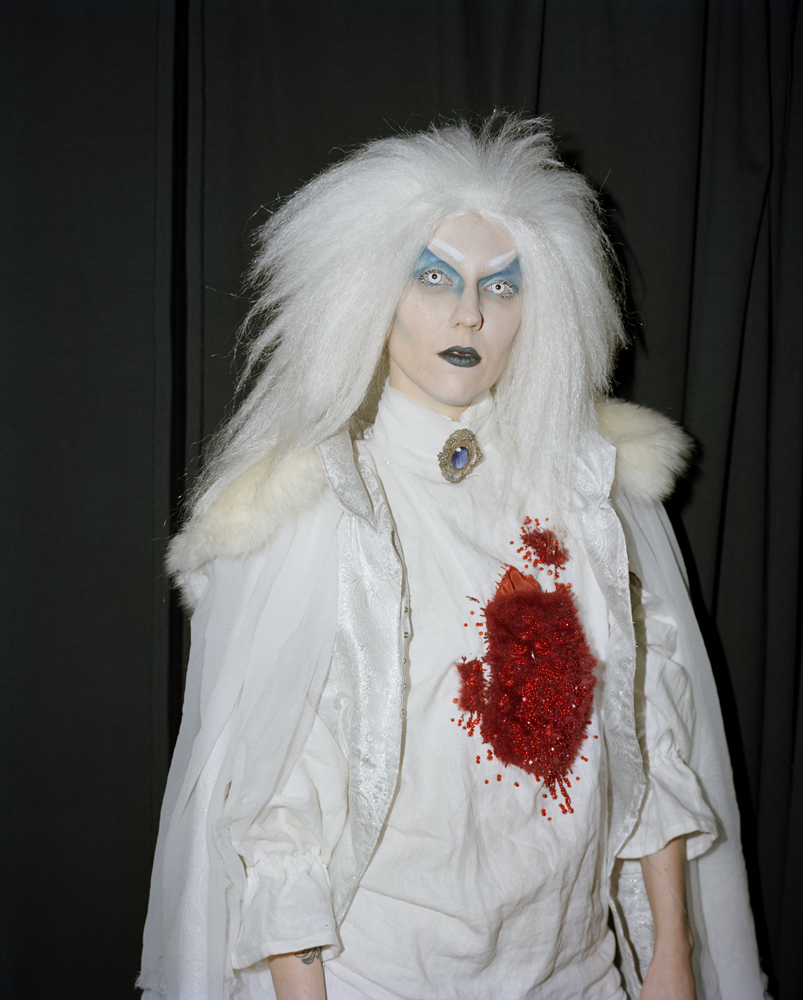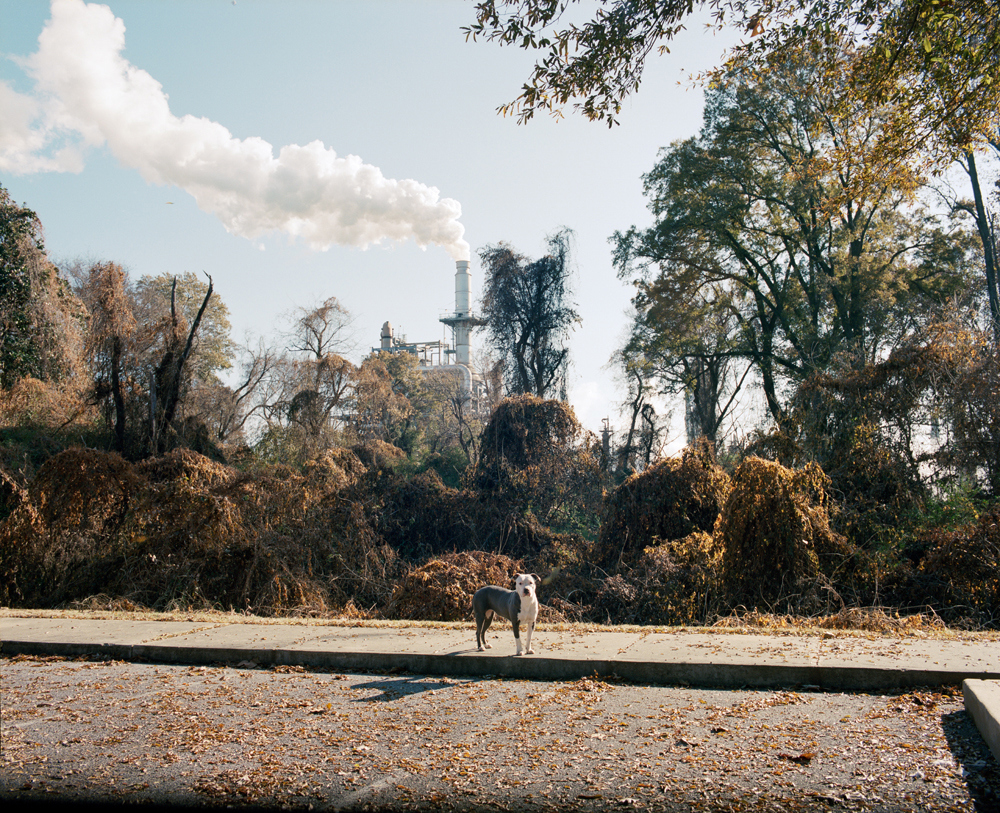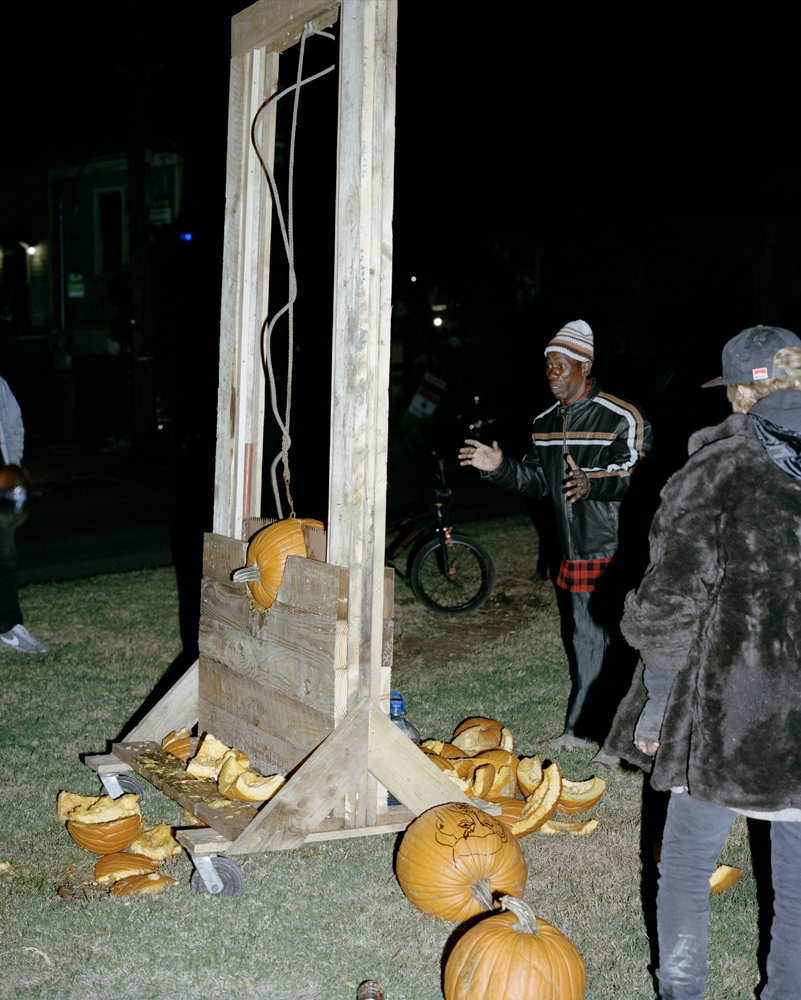Jack Young in Conversation with Kelsey Sucena

© Kelsey Sucena, Election Day, Seattle, 2016
Kelsey Sucena’s body of work, Paralytic States, is necessary. Their images and writing speak to how important it is to pay attention to the world outside and inside of ourselves when we feel we no longer can. Kelsey’s ability to thread the loss of security during the 2016 presidential election with questioning and understanding their gender identity is not only brave but impressive in the breadth of what is found in their images. Often times violent, loving, transcendent, and overwhelming, Paralytic States is a testament to the power of truth, projection, and identity. I invite fellow viewers and readers to engage with Kelsey’s work as I have: out of necessity.

© Kelsey Sucena, Dad, Long Island, 2018
Jack Young: How and why did this work begin?
Kelsey Sucena: Paralytic States had a few flashpoints, but I’d say the most notable one was the 2016 election. 2016 was a charged year. For me, it marked the difficult questioning of my gender identity as I began to come into myself as trans*/nonbinary. I was actively probing whether or not to come out just as the election eroded what little sense of security I had. It not only drove me back into the closet, but it also created a chasm between myself and my family.
So, the project emerged there, from a sense of urgency. Political urgency. Artistic and cultural urgency. Personal urgency. I worked on it for many years, but the whole time there was this sense that the house was on fire, shit was going down, and I absolutely had to figure things out. To respond to the moment with what it deserved.

© Kelsey Sucena, Walmart, El Paso, 2019

© Kelsey Sucena, Chevy Lace, Bushwick, 2019
JY: First, I’m intrigued by the title you gave your body of work, Paralytic States. For me, the word “paralytic” implies an inability to move, while “states” offers the notion that there are subtle nuances between certain moments or periods of time. The words put together offer an interesting juxtaposition of what is static and the potentiality of change. Because words and writing play such a pivotal role in this work, I’m wondering if there was a certain way you hoped viewers and readers would approach this work with its title in mind?
KS: If there’s any brilliance in the name, then it’s all owed to Laura Jane Grace of the band Against Me!. It’s the name of a song from her revolutionary album Transgender Dysphoria Blues. I’ve always resonated with that song, as well as the whole album, as a riotous expression of Trans* identity which, before I discovered it, I couldn’t even imagine. Within it, Grace paints a vivid picture of gender dysphoria.
So yeah. That title made sense to me because this work was very much an expression of the complex inner life that arises from paralysis. What’s been called analysis paralysis, that type of paralysis wherein you’re trying to decide what to do when faced with a tough situation, is anxious but full of potential energy, and I’ve thought of this work as being similarly charged.
But, to be honest it’s not all serious. I also think of the title as a bit of a pun, since in many ways it feels like the United States is paralyzed by itself. Viewers can pull from that title anything that feels appropriate. What I like about it is, yes, it opens things up to interpretation.

© Kelsey Sucena, AJ, Inwood, 2018
JY: Paralytic States isn’t only a view of the United States after the 2016 election. It also gives a look into who you are as a trans*/nonbinary photographer and writer. When you think about identity in relation to the images you made and the essays you wrote, how did they come together to give you the agency to understand the world inside and around you?
KS: There were whole months when I felt like I was drowning inside of my own head, but through writing I found an outlet for those feelings, and through photography I was able to anchor myself during what felt like dissociative fugues. In that way Paralytic States was therapeutic. It was this deeply personal space wherein I could invest time and energy into understanding who I am, and what world I live in.
Artistic practices are like that sometimes. While I don’t believe that art can solve our problems, it does take an immense amount of agency to justify calling yourself an artist. As a closeted Trans*/nonbinary person, that sense of agency was something I often lacked. The bull-headed pursuit of art in creating this project did wonders in helping to build me up, in helping me to understand that if I can create art then I can also create myself. In that way my body becomes canvas. My identity, an essay or sequence of images, tenable, beautiful, and also worthy of revision.

© Kelsey Sucena, Valero Refinery, Memphis, 2019
JY: There are several images in this work that capture smoke, be it from an industrial plant, fired gun, or a burning fire. These images, but specifically the smoke captured in them, appear to speak to America’s harmful habits of colonization, violence, and oppression against itself and the planet. What was the process like identifying these ominous “moments” or “states” you felt compelled to photograph?
KS: Shit, well.
When I photograph I usually do so intuitively, so it’s hard to describe the thought process. I find that in approaching a new landscape, the place where I train my camera can be quite revealing, whether or not I’m aware of what it’s saying when I do. There’s a subconscious pull there. It’s one that often follows my general affect (whether that’s anxiety, frustration, fear, awe, joy) and points me, like an inefficient form of psychotherapy, to what’s on my mind. Smoke can be scary, can point to climate change and forest fires, tear gas, or bullets. It can also be really beautiful, full of shifting tones and forms. So, as something that terrifies and dazzles me, I realize in retrospect that I tend to photograph it a lot.
But every so often I set out to make photographs intentionally. I’m usually not very successful in this, and even when I do some degree of chance is necessary to make the images work. In 2019, as I traveled across country, I realized my route would take us to El Paso and Vegas, where terrible acts of mass violence had recently occurred. I made a point to visit those sites because I think of them as expressions of all of those things you pointed to in your question. Colonization, white supremacy, ecological annihilation, economic stratification. To me the images become artifacts of the darkest tendencies embedded within the history of the United States and within its exploitative/extractive imperial culture. The photographs of smokestacks do that too.

© Kelsey Sucena, Guillotine on Neutral Ground, New Orleans, 2019
JY: This body of work, as mentioned in your statement, shows the United States after its political shift in 2016 with Trump being elected president. How did you motivate yourself to capture the nation during such a tumultuous time? Did your work ever deviate from what it is now?
KS: As I mentioned before, it felt like the house was on fire and I had to respond. As photographers I think we have this very specific (and sometimes suspect) relationship to time. There’s an expectation to engage with it, to place our bodies there making images of history as it’s being made. As artists, there’s skepticism too. I have to ask myself ‘what role do cameras play through all of this’? ‘Does it help to make pictures of a crumbling world’? ‘What right do I have to speak on history’? ‘What privileges have been afforded to me (a white person with a college education) that enable me to pursue this where others cannot’?
I don’t know that I can say I really captured the nation during this tumult, but I do know that this work has become something of a diary. It speaks to my perspective, to the way in which history has affected/effected me, and when I open it, expose myself a bit, other people begin to expose themselves too. In sharing this project with others I have been surprised and comforted to find that they often resonate with it on some level in a way that encourages them to share their own experiences, traumas, hopes, and perspectives. I’ve often called Paralytic States a ‘broken silence’ for that reason. That broken silence is what motivates me.
As to deviation, Paralytic States often deviated in form, but generally the content has remained the same. I actually prefer to present this work as a kind of spoken word slide show, wherein the intimacy of the text takes center stage within a crowded room. With Covid, it hasn’t been possible to bring people together the way I’d usually prefer and so I figured this printed form is the next best thing.

© Kelsey Sucena, Halloween, New Orleans, 2019
JY: Dogs are also important to this work. In one of your essays, you mention they are subjects which photographers can project their “internal realities.” What was the most surprising thing you learned about yourself in relation to the dogs you photographed and wrote about?
KS: Once, when I was younger, I wrote a list down of things I’d like to photograph more often. “Dogs” were at the very top. My Dad found that list scrawled away in a journal and interrogated me about it. “Why the fuck do you want to photograph dogs?” He didn’t see the value in it, and neither did I, which is why I like to photograph them.
As a photographer I suspect that I’m always projecting, as much as I am capturing, whenever I am making images. I hope that there’s reciprocity there, that the subject and I are working in collaboration, but try to keep sober about my own limitations. As people, we often project our subjectivity onto dogs because they don’t really have the agency to reject our projections. I feel bad for them mostly.
But allow me to project for a minute: I grew up with dogs, but now I live with cats. So when I encounter dogs out in the real world they bring me back to life at home. Anxious animals. I can’t imagine what it’s like to be a social creature, embedded within a society wherein the predominant forms of communication are so completely alien to you. But then, as I’m writing this, I realize that I do. It’s kind of like gender. Like being displaced from yourself because of your body, if that makes sense.

© Kelsey Sucena, Mandalay Bay, Las Vegas, 2019
JY: What’s next for you?
KS: I’m not really sure. I’m looking to formally publish Paralytic States. The last publication was a small, in-house, DIY run that I distributed for free to friends. I’d like to disseminate an updated and larger version more widely but can’t really afford to take that on alone. We’ll see how that goes.
I have a few exciting things coming up. I’m currently showing work at Photographic Center Northwest alongside some truly astounding photographers. The show Pained Vistas, explores traumatized, colonized, and exploited landscapes through photography. We’ll be chit-chatting about it on February 16th.
I also launched a really cheap website to host a variety of new projects I’ve been working on. I’d call them doodles and think about it as a generative space for new and rough ideas. I’ll be updating the website monthly. Folks can check it out at new-bodies.net.
I’ve been working my ass off to be honest. I’ve got my day job, a few freelance gigs, and my own stuff. I just started teaching a class on Image/Text with some brilliant students at the Purchase College School of Art and Design. Otherwise I’m also trying to focus on my transition, and on keeping myself healthy by exercising in the woods near my house. It’s a lot, but we manage.

© Kelsey Sucena, Shit Stream, Salton Sea, 2019

© Kelsey Sucena, Venice Beach, 2019
JY: Who or what is inspiring you right now? Any artists, musicians, books, TV shows, films, etc.?
KS: There is so much inspiring me right now!
I’ve been mulling over a book I read a few months back, “Capital Is Dead, is This Something Worse?” by Mckenzie Wark, and thinking about it in relation to the extractive economies of instagram, photography, and the art world more broadly. Wark’s proposition that Capitalism as the dominant mode has been subsumed by what she calls Vectoralism has massive implications for artists in understanding how we are being exploited, and where to situate our class interests.
I’ve also been rewatching Star Trek and am thrilled by the queerness of it all. It’s a surprising show that’s ahead of its time in many ways, perhaps behind in others. I often find that it stumbles into its queer themes on accident, but when it does it seems to stick the landing.
My friend Carla Liesching has an incredible book called “Good Hope” which came out recently through MACK, and I think everyone should check it out. And my friend Jason Liepeles put a book out awhile back called “Letters to M” through Pilot Press. It’s absolutely worth a read.
And of course, there are so many photographers out there making work that I love and respect, but I don’t want to list some and accidentally forget others, so if anyone is looking for recommendations please DM me and I’d be happy to share them with you.
JY: Kelsey, you have such a keen eye and a unique, effective way with words. Thank you so much for your time.
KS: Thank you so much Jack. Talking with you has been a profound pleasure.

© Kelsey Sucena, View of Golden Gate, San Francisco, 2019
Kelsey Sucena (they/them) is a transfeminine photographer, writer, adjunct educator, and park ranger currently residing on Long Island. Their work rests at the intersection of photography and text, often within the bodies of performative slideshows and photo-text-books. It is centered broadly upon the United States as a site for anti-capitalist, queer, and critical reflection. Kelsey is an MFA graduate from Image Text Ithaca (2020), Managing Editor of The Photocaptionist, and a freelance writer with contributions to Float Photo Magazine, Rocket Science, and 10×10 Photobooks. They currently teach at the School of Art and Design, Purchase College and work as a visual information specialist on Fire Island.
Follow them on Instagram: @kelsey_sucena
Jack Young is a musician and writer from Lexington, South Carolina. His work explores the effects of abuse and trauma, growing up gay in the South, and reclaiming power over his sexual identity. In 2020, Jack graduated from Savannah College of Art and Design with a B.F.A. in Writing.
Follow him on Instagram: @youngjackyoung
Posts on Lenscratch may not be reproduced without the permission of the Lenscratch staff and the photographer.
Recommended
-
Kevin Cooley: In The Gardens of EatonJanuary 8th, 2026
-
William Karl Valentine: The Eaton FireJanuary 7th, 2026
-
Sean Stanley: Ashes of SummerJanuary 6th, 2026
-
Nathan Bolton in Conversation with Douglas BreaultJanuary 3rd, 2026
-
Andrew Lichtenstein: This Short Life: Photojournalism as Resistance and ConcernDecember 21st, 2025
























































